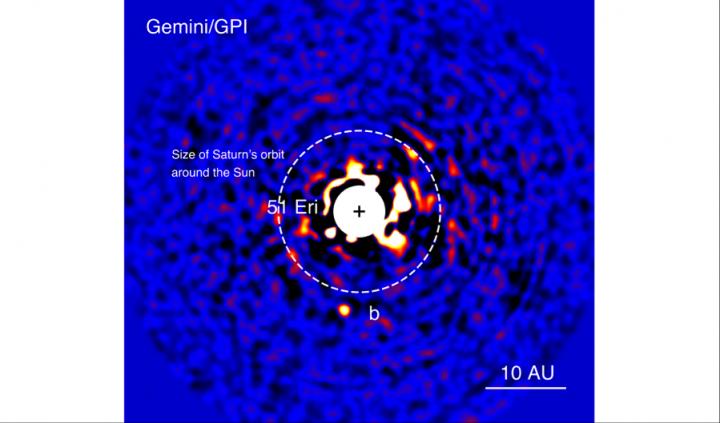The Gemini Planet Imager has made its first discovery, and this new exoplanet could unravel the secrets of Jupiter’s birth.
The latest news in planet-hunting comes from the Gemini Planet Imager, a new instrument that can spot much smaller, younger planets than previous technologies have been able to. Its first discovery is 51 Eridani b, an exoplanet that bears remarkable similarities to Jupiter.
However, this exoplanet is only about 20 million years old, which makes it a baby compared to Jupiter’s venerable age of 4.5 billion years. Its youth means 51 Eridani b still carries imprints from its formation, and studying it could reveal whether Jupiter formed in the same process. The exoplanet comes the closest to Jupiter’s mass out of any other planets found thus far, and it also resembles our gas giant with its methane-abundant atmosphere.
The Gemini Planet Imager (GPI) discovered 51 Eridani b through direct imaging. Unlike other methods of planet detection, GPI is tailor-made to find relatively young stars that may overshadow the planets orbiting them. The instrument focuses on the image of a star, and then uses special masks to block out its light so that the remaining spots of brightness can be analyzed. This method allows GPI to detect planets that are still radiating light from their recent formations. GPI also uses corrective optics to filter out other light sources in Earth’s atmosphere, so that the planet’s image offers accurate, comprehensive information about its energetic and chemical properties.
 |
Previously discovered exoplanets have measured much hotter than 51 Eridani b, which is only 800 degrees Fahrenheit. Astronomers believe that higher temperatures indicate a “hot start” type of formation, where huge clouds of gas rapidly collapse and condense to form gas giants with residual high energy. 51 Eridani b, on the other hand, may have formed via core accretion, in which a rocky core gradually builds up over a few million years and then attracts gasses to form its atmosphere.
Many scientists theorize that the planets of our solar system formed through core accretion, whereas other exoplanets appear to have formed through the “hot start” process. 51 Eridani b will give them the opportunity to study a younger version of Jupiter and see whether core accretion is truly unique to our solar system.
The next step is to take more measurements that will determine the chemical components of the planet’s atmosphere. The light that 51 Eridani b emits will allow scientists to sample the chemical structures of different atmospheric layers. This is the first exoplanet to be discovered with this specific combination of properties, and further observations will reveal just how similar it is to our local planets. GPI will also continue to bring in more imaging data that will yield exciting new discoveries.
Based on materials provided by the University of California - Berkeley and the University of Montreal.








Facebook comments